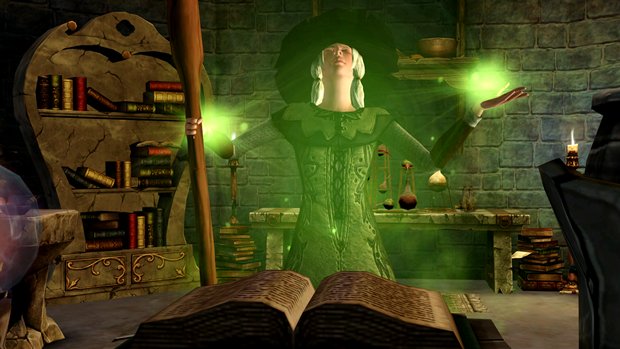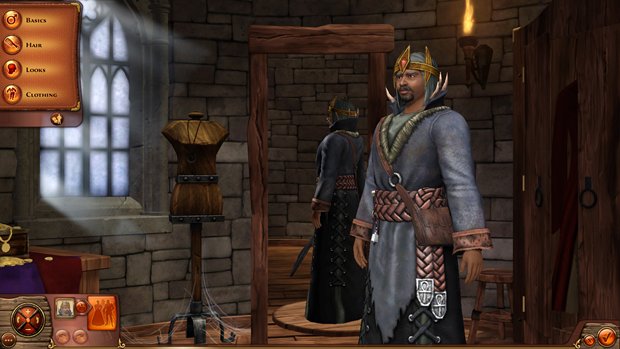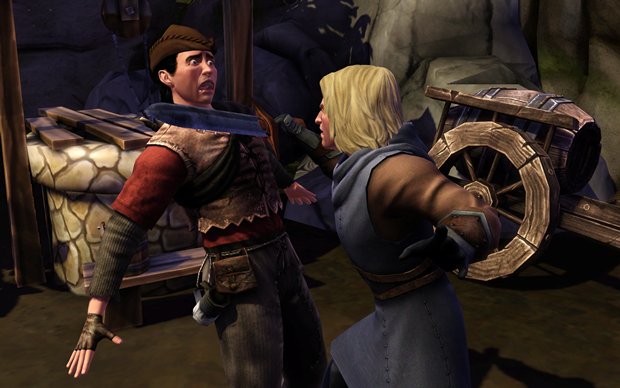The Sims Medieval: Hands-on preview
Ditch the the 9 to 5 and grab a crown, that throne needs filling
It may seem like a bizarre comparison, but the first game that came to mind while watching The Sims Medieval in action was Civilization V. Now before you burn me at the cross for such a bizarre comparison, bare with me. The biggest change-up inMedieval is clearly the setting, but the game has also adopted some more traditional gaming elements to help draw in gamers who’ve dismissed the franchise as more of a plaything than a traditional game. Filled to the brim with more conventional quests, plotlines and goals that traditional gamers can relate to, Medievalcould be The Simsgame that draws in the core audience.

Above: No matter how hard I squint and strain I still can't make green fireballs. Red ones, yes, but no green.
One of the most interesting parts ofMedieval is that because of the time period, the player no longer has to worry about their character gallivanting off to work for 8 hours everyday. By focusing on the king and his closest advisors, the day to day grind is much more interesting. Players can jump between the King, the Physician, the Spy, the Wizard or thePriest at any time, all of whom are created by theplayer. Mediating arguments between two angry citizens, practicing magic spellsand brokering trade agreements with nearby kingdoms is a lot more interesting than sending your Sim off to the cracker factory for the day. Even if your Sim is a pretty big wheel down at the cracker factory.
Medieval has an interesting mix of macro and micro gameplay, alternating focus between the individual characters in your kingdom and the progress of the kingdom as a whole.Once you’ve stepped into the shoes of a character, you can then pick from a list of quests specific to that class. Each questline has its own story composed of multiple tasks that you’ll have to complete; these side quests have a number of rewards, primarily Kingdom Points, or KP. KP is used to purchase major upgrades for your kingdom, including new buildings, skills or cultural achievements. Achieving your main ambition is the overarching goal, things like expanding thesize of the kingdom, and you'll need a fairamount of KP per playthrough to do it.
The quest we saw involved stopping a mysterious witch who had been attacking citizens and was quickly posing a threat to the kingdom itself. We were given an option of how to deal with the witch; we could use our Spy to kill her, our Priest to exorcise her, or our Wizard to out-magic her. We decided fighting fire with fire would be the best plan of action and selected the Wizard. Once a character is locked into a quest line he's still responsible for his regular daily tasks, but the other characters automate themsleves, allowing you to get into character a bit more.

Above: "Morgana? Does this man-purse match my sash?"
After a quick mission in the woods collecting ingredients for a spell, we were informed of the witch's most recent doings by a terrified citizen outside of the forest. Taking our newfound knowledge back to the court, we approached the King, asking for assistance in dealing with the witch. Unfortunately, the King refused to take our warning seriously enough to do anything to help. It’d require more proof before he’d lend a hand. From here the mission would progress via a series of quests, each testing the character’s abilities and, ultimately, if successful, awarding the player with much needed KP, additional resourcesand upgraded skills.
Sign up to the GamesRadar+ Newsletter
Weekly digests, tales from the communities you love, and more
Medieval also features some interesting branching paths for your kingdom; two rival religions, the Jacoban and the Peteran, offer your kingdom specific benefits. We opted for the moreGothic of the two, at which point an enormous church was erected, covered in pointy spires and stained glass windows. Character creation is still a huge part of the game, and each character has a wide range of outfits and color choices as well ascustomizable personality traits. Each characters must have a "Fatal Flaw" though, a major personal problem that can impede their reliability or success; the Priest we created was a closetalcoholic.Each character can complete a special quest line to overcome their Fatal Flaw at some point, but it won't be easy. Knowing your hereoes can be unreliable at times makes them a little more interesting, it's not fun if they win all the time.

Above: "Good lord man! I've never seen such severe split ends!"
Building up other parts of your kingdom, like the smithy and themarket, are also important, as they keep your citizens happy and productive. Youcould starve them and force them to go to war with the nearby territories, but don't expect them to be happy about it.Graphically, Medieval looks great, capturing the Sims style and wraping it in beautiful fantasy buildings and colorful clothes.
With it’s clever mix of macro and micro goals, The Sims Medieval looks like it’s creating an experience that will appeal not only to Sims fans, but to “core” gamers who may have shunned the series before. Its slightly more goal driven nature and geek-friendly fantasy themeshould also help.Even then, thegame still has all the classic Sims touches that traditional fans love: ahigh level of customization, open ended gameplay and, of course, voyeuristic stimulation. So don your crown, raise your mead and get ready to peer into the lives of your new subjects.
The Sims Medieval is set to release on PCs and Macs in March 2011
Nov 23, 2010



